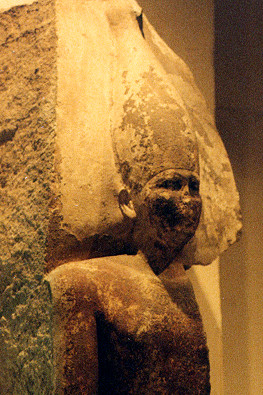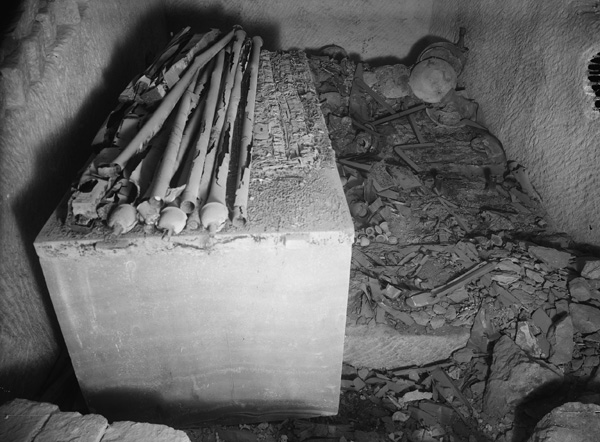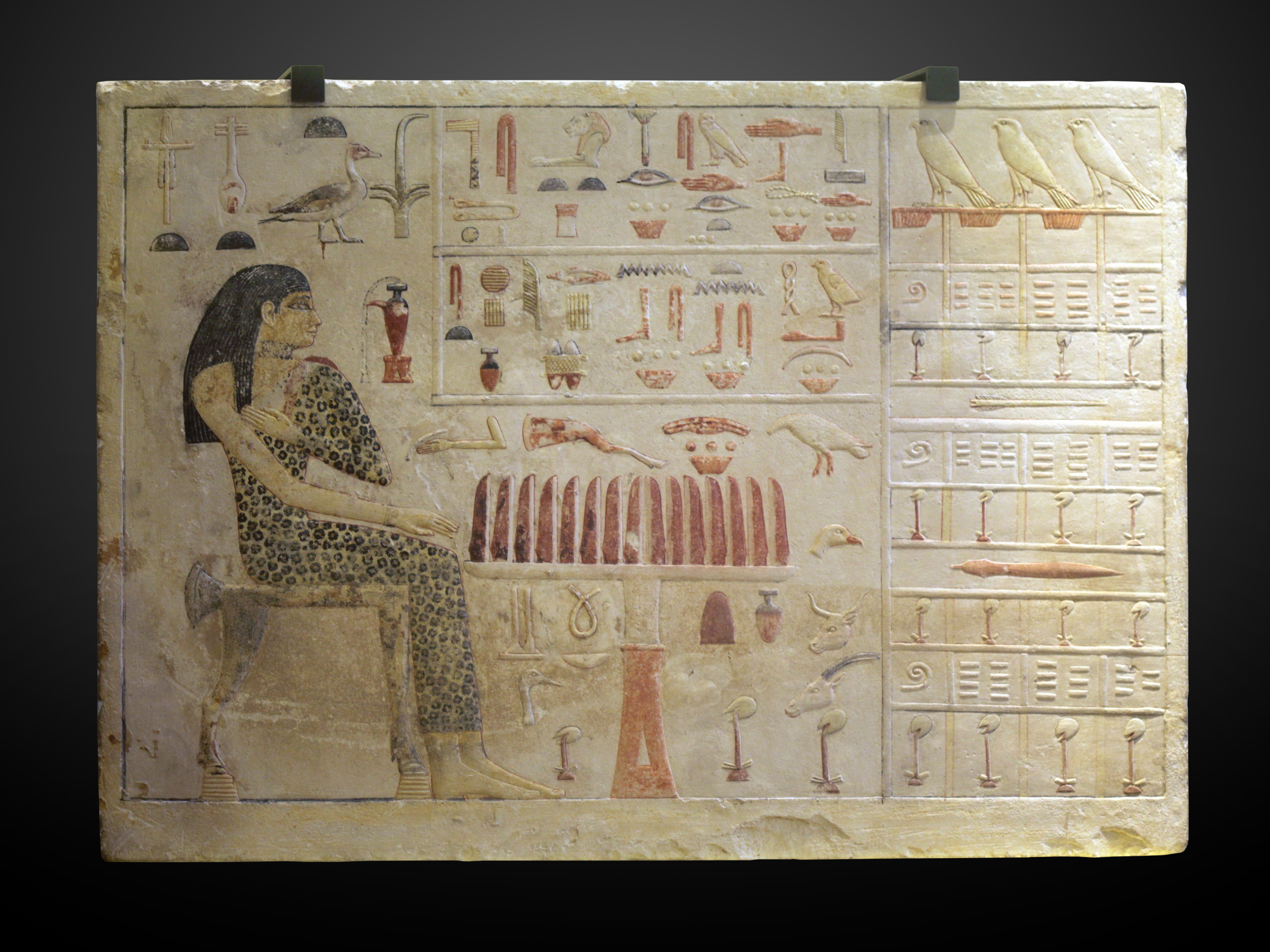|
Kheops
Khufu or Cheops was an ancient Egyptian monarch who was the second pharaoh of the Fourth Dynasty, in the first half of the Old Kingdom period (26th century BC). Khufu succeeded his father Sneferu as king. He is generally accepted as having commissioned the Great Pyramid of Giza, one of the Seven Wonders of the Ancient World, but many other aspects of his reign are poorly documented. The only completely preserved portrait of the king is a three-inch high ivory figurine found in a temple ruin of a later period at Abydos in 1903. All other reliefs and statues were found in fragments, and many buildings of Khufu are lost. Everything known about Khufu comes from inscriptions in his necropolis at Giza and later documents. For example, Khufu is the main character noted in the Westcar Papyrus from the 13th dynasty. Most documents that mention king Khufu were written by ancient Egyptian and Greek historians around 300 BC. Khufu's obituary is presented there in a conflicting wa ... [...More Info...] [...Related Items...] OR: [Wikipedia] [Google] [Baidu] |
Great Pyramid Of Giza
The Great Pyramid of Giza is the biggest Egyptian pyramid and the tomb of Fourth Dynasty pharaoh Khufu. Built in the early 26th century BC during a period of around 27 years, the pyramid is the oldest of the Seven Wonders of the Ancient World, and the only one to remain largely intact. As part of the Giza pyramid complex, it borders present-day Giza in Greater Cairo, Egypt. Initially standing at , the Great Pyramid was the tallest man-made structure in the world for more than 3,800 years. Over time, most of the smooth white limestone casing was removed, which lowered the pyramid's height to the present . What is seen today is the underlying core structure. The base was measured to be about square, giving a volume of roughly , which includes an internal hillock. The dimensions of the pyramid were high, a base length of , with a seked of palms (a slope of 51°50'40"). The Great Pyramid was built by quarrying an estimated 2.3 million large blocks weighing 6 million tonnes ... [...More Info...] [...Related Items...] OR: [Wikipedia] [Google] [Baidu] |
Khufu Ship
The Khufu ship is an intact full-size solar barque from ancient Egypt. It was sealed into a pit at the foot of the Great Pyramid of pharaoh Khufu around 2500 BC, during the Fourth Dynasty of the ancient Egyptian Old Kingdom. Like other buried Ancient Egyptian ships, it was apparently part of the extensive grave goods intended for use in the afterlife. The Khufu ship is one of the oldest, largest and best-preserved vessels from antiquity. It is long and wide, and has been identified as the world's oldest intact ship, and described as "a masterpiece of woodcraft" that could sail today if put into a lake or a river. The ship was preserved in the Giza Solar boat museum, but was relocated to the Grand Egyptian Museum in August 2021. History Function The history and function of the ship is not precisely known. It is of the type known as a "solar barge", a ritual vessel believed by ancient Egyptians to carry the resurrected king across the heavens with the sun god Ra. However, ... [...More Info...] [...Related Items...] OR: [Wikipedia] [Google] [Baidu] |
Khufu Wadi Maghara RIGHT
Khufu or Cheops was an ancient Egyptian monarch who was the second pharaoh of the Fourth Dynasty of Egypt, Fourth Dynasty, in the first half of the Old Kingdom of Egypt, Old Kingdom period (26th century BC). Khufu succeeded his father Sneferu as king. He is generally accepted as having commissioned the Great Pyramid of Giza, one of the Seven Wonders of the Ancient World, but many other aspects of his reign are poorly documented. The only completely preserved portrait of the king is Khufu Statuette, a three-inch high ivory figurine found in a temple ruin of a later period at Abydos, Egypt, Abydos in 1903. All other reliefs and statues were found in fragments, and many buildings of Khufu are lost. Everything known about Khufu comes from inscriptions in his necropolis at Giza pyramid complex, Giza and later documents. For example, Khufu is the main character noted in the Westcar Papyrus from the Thirteenth Dynasty of Egypt, 13th dynasty. Most documents that mention king Khufu were ... [...More Info...] [...Related Items...] OR: [Wikipedia] [Google] [Baidu] |
Fourth Dynasty Of Egypt
The Fourth Dynasty of ancient Egypt (notated Dynasty IV) is characterized as a "golden age" of the Old Kingdom of Egypt. Dynasty IV lasted from to 2494 BC. It was a time of peace and prosperity as well as one during which trade with other countries is documented. The Fourth Dynasty heralded the height of the pyramid-building age. The relative peace of the Third Dynasty allowed the Dynasty IV rulers the leisure to explore more artistic and cultural pursuits. King Sneferu's building experiments led to the evolution from the mastaba-styled step pyramids to the smooth sided “true” pyramids, such as those on the Giza Plateau. No other period in Egypt's history equaled Dynasty IV's architectural accomplishments.Egypt: Land and Lives of the Pharaohs Revealed, (2005), pp. 80–90, Global Book Publishing: Australia Each of the rulers of this dynasty (except for Shepseskaf, the last) commissioned at least one pyramid to serve as a tomb or cenotaph. The Fourth Dynasty was the sec ... [...More Info...] [...Related Items...] OR: [Wikipedia] [Google] [Baidu] |
Khufu Statuette
The Khufu Statuette or the Ivory figurine of Khufu is an ancient Egyptian statue. Historically and archaeologically significant, it was found in 1903 by Sir Flinders Petrie, William Matthew Flinders Petrie during excavation of Kom el-Sultan in Abydos, Egypt, Abydos, Egypt. It depicts Khufu, a Pharaoh of the Fourth Dynasty of Egypt, Fourth dynasty (Old Kingdom of Egypt, Old Kingdom, c. 2613 to 2494 BC), and the builder of the Great Pyramid of Giza, Great Pyramid, though it may have been carved much later, in the Twenty-Sixth Dynasty, 664 BC–525 BC. This small seated figure is the only known three dimensional depiction of Khufu which survives largely intact, though there are also several statue fragments. Most Egyptologists consider the statue contemporary with Khufu very likely from his reign. However, because of the unusual provenance, its dating has been repeatedly questioned. The Egyptologist Zahi Hawass doubts that the statuette dates to the Old Kingdom at all. His argument ... [...More Info...] [...Related Items...] OR: [Wikipedia] [Google] [Baidu] |
Meritites II
Meritites II (Merytiotes, Meritetes) or Meritites A ("beloved of her father") was a 4th Dynasty princess of ancient Egypt, probably a daughter of King Khufu. She may have been a daughter of Meritites I based on the fact that this queen is mentioned in mastaba G 7650. She married the Director of the Palace, Akhethotep (a non-royal court official), and she had several children with her husband. Meritites and her husband shared a mastaba G 7650 in Giza. Family and early life Meritites II was probably a daughter of Khufu, as she was said to be a ''King's daughter of his body'' and as the location of her tomb indicates a relation to Khufu. She was a Prophetess of Khufu, Hathor and Neith. Meritites was married to Akhethotep, who was a director of the palace. Further titles of Akhethotep include ''Sole friend'', ''Priest of the Bas of Nekhen'', and ''Overseer of fishers/ fowlers''.Flentye, Laurel. "The Mastabas of Ankh-haf (G 7510) and Akhethetep and Meretites (G 7650) in the Eas ... [...More Info...] [...Related Items...] OR: [Wikipedia] [Google] [Baidu] |
Hetepheres I
Hetepheres I was a queen of Egypt during the Fourth Dynasty of Egypt (c. 2600 BC) who was a wife of one king, the mother of the next king, the grandmother of two more kings, and the figure who tied together two dynasties. Biography Hetepheres I may have been a wife of King Sneferu, and was the mother of King Khufu. It is possible that Hetepheres had been a minor wife of Sneferu and only rose in prominence after her son ascended the throne. She was the grandmother of two kings, Djedefre and Khafre, and of queen Hetepheres II. Her titles include: King's Mother (''Mut-nisut, mwt- nswt''), Mother of the King of the Two Lands (''Mut-nisut-biti, mwt- nswt- bjtj''), Attendant of Horus (''Khet-heru, ḫt-hrw''), and God's Daughter of his body (''Zat-netjer-net-khetef,'' '' zꜣt- nṯr- nt- ẖt .f'').Grajetzki, ''Ancient Egyptian Queens – a hieroglyphic dictionary'', London, 2011. The marriage of Hetepheres I to Snefru solidified his rise to the throne. Because she carrie ... [...More Info...] [...Related Items...] OR: [Wikipedia] [Google] [Baidu] |
Khamerernebty I
Khamerernebty I was an ancient Egyptian queen of the 4th dynasty. She was probably a wife of King Khafre and the mother of King Menkaure and Queen Khamerernebty II. It is possible that she was a daughter of Khufu, based on the fact that inscriptions identify her as a King's daughter. Life Khamerernebty I is identified with the king's mother whose partial name was found inscribed on a flint knife in the mortuary temple of Menkaure. She is thought to be the mother of Menkaure and was likely married to King Khafre. There are no inscriptions that explicitly mention her as a wife of Khafre however. The Galarza tomb in Giza was originally probably built for Khamerernebty I, but was finished for her daughter Khamerernebty II. The inscriptions in this tomb are an important source of information about Khamerernebty I.Baud, Michel. "La tombe de la reine-mère xa-mrr-Nbtj Ire." Bulletin de l'Institut Français d'Archéologie Orientale 95 (1995), pp. 11-12, 18, fig. 1. The lintel above th ... [...More Info...] [...Related Items...] OR: [Wikipedia] [Google] [Baidu] |
Nefertiabet
Nefertiabet (''nfrt-jꜣbt''; "Beautiful One of the iabet, East") was an ancient Egyptian princess of the Fourth Dynasty of Egypt, 4th Dynasty. She was possibly a daughter of Pharaoh Khufu. Tomb Her tomb at Giza is known (G 1225). The mastaba is about 24.25 x 11.05 m. in size. A statue of her, now in Munich, probably originates from her tomb. There is a well-known slab stela depicting the princess that is now in the Louvre., p.60 Nefertiabet is shown seated facing right. She is depicted with a long wig and a panther-skin garment. An offering table in front of her bears reeds, as is common, indicating "[the products of the] field", as well as sundry other foodstuffs. Under the table offerings are depicted including linen and ointment on the left, and on the right offerings of bread, beer, oryx, and bull. On the right of the slab a linen list is depicted. The tomb originally contained one shaft, which contained the burial of Nefertiabet. The shaft comprises a passage and a chambe ... [...More Info...] [...Related Items...] OR: [Wikipedia] [Google] [Baidu] |
Horbaef
Horbaef (also known as Baefhor and Horbaf) was an ancient Egyptian prince of the 4th Dynasty. His title was "King’s son". Horbaef was a son of Pharaoh Khufu and an unknown woman. He married his half-sister Meresankh II,Her mother was very likely Meritites I. and they had two daughters, the ladies Nefertkau III and Nebty-tepites. They may have also had one son called Djaty. After Horbaef’s death, his widow Meresankh married a pharaoh, her other half-brother, either Djedefra or Khafre, and thus she became a queen. It’s possible that Djaty was a son of Meresankh’s second husband because he had a title "king’s son of his body", and Horbaef was a prince but never a king. Horbaef was buried in the mastaba G 7410-7420 at Giza Giza (; sometimes spelled ''Gizah'' arz, الجيزة ' ) is the second-largest city in Egypt after Cairo and fourth-largest city in Africa after Kinshasa, Lagos and Cairo. It is the capital of Giza Governorate with a total population of 9.2 .... ... [...More Info...] [...Related Items...] OR: [Wikipedia] [Google] [Baidu] |
Khufukhaf I
Khufukhaf I (also read as Khaefkhufu I) was an ancient Egyptian prince and vizier of the 4th Dynasty. Family Khufukhaf was a son of pharaoh Khufu, half-brother of pharaoh Djedefre and full brother of pharaoh Khafre and prince Minkhaf., p.60 His mother might have been Queen Henutsen; the latter's pyramid is next to his mastaba tomb. His wife was named Nefertkau II and she was buried with him in Giza.Porter and Moss, Topographical Bibliography of Ancient Egyptian Hieroglyphic Texts, Reliefs, and Paintings; Part III Life He served as vizier, possibly towards the end of Khufu's reign or during his brother Khafra's reign. Tomb Khufukhaf had a double mastaba in Giza (tomb G 7130-7140) in the east field which is part of the Giza Necropolis. Mastaba G 7130 is attributed to Khufukhaf's wife Nefertkau. G 7140 belonged to Khufukhaf himself. Khufukhaf is depicted with Queen Henutsen in the Hall of the Mastaba. Several sons are mentioned as well. A son named Wetka (also called Tuka) is ... [...More Info...] [...Related Items...] OR: [Wikipedia] [Google] [Baidu] |




.jpg)

